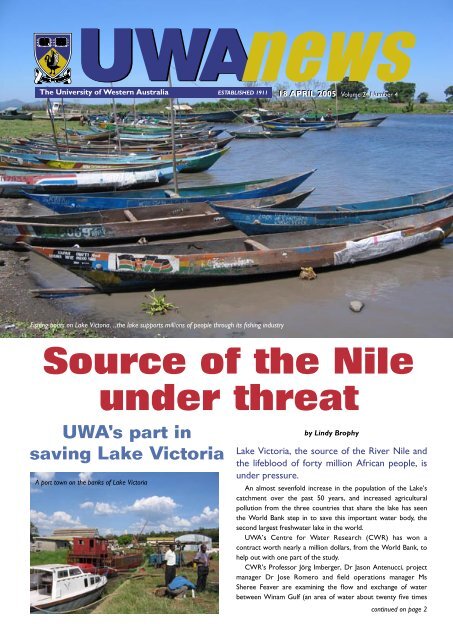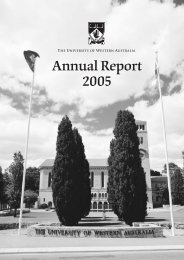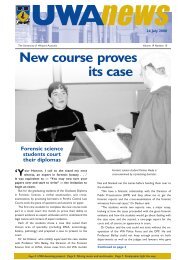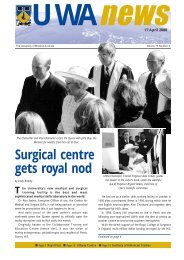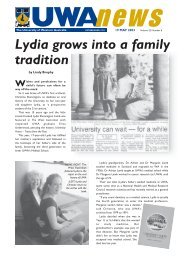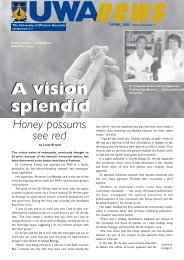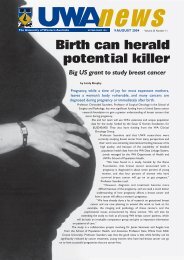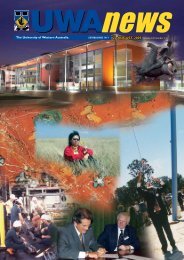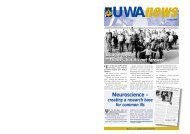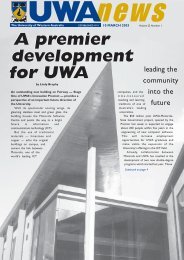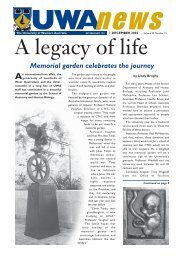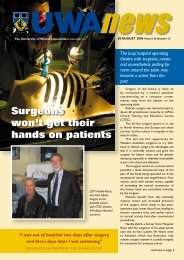18 Apr: Vol 24, #4 - UWA News staff magazine - The University of ...
18 Apr: Vol 24, #4 - UWA News staff magazine - The University of ...
18 Apr: Vol 24, #4 - UWA News staff magazine - The University of ...
Create successful ePaper yourself
Turn your PDF publications into a flip-book with our unique Google optimized e-Paper software.
<strong>UWA</strong><strong>18</strong>news<strong>The</strong> <strong>University</strong> <strong>of</strong> Western Australia ESTABLISHED 1911<strong>18</strong> APRIL 2005 <strong>Vol</strong>ume <strong>24</strong> Number 4Fishing boats on Lake Victoria…the lake supports millions <strong>of</strong> people through its fishing industrySource <strong>of</strong> the Nileunder threat<strong>UWA</strong>’s part insaving Lake VictoriaA port town on the banks <strong>of</strong> Lake Victoriaby Lindy BrophyLake Victoria, the source <strong>of</strong> the River Nile andthe lifeblood <strong>of</strong> forty million African people, isunder pressure.An almost sevenfold increase in the population <strong>of</strong> the Lake’scatchment over the past 50 years, and increased agriculturalpollution from the three countries that share the lake has seenthe World Bank step in to save this important water body, thesecond largest freshwater lake in the world.<strong>UWA</strong>’s Centre for Water Research (CWR) has won acontract worth nearly a million dollars, from the World Bank, tohelp out with one part <strong>of</strong> the study.CWR’s Pr<strong>of</strong>essor Jörg Imberger, Dr Jason Antenucci, projectmanager Dr Jose Romero and field operations manager MsSheree Feaver are examining the flow and exchange <strong>of</strong> waterbetween Winam Gulf (an area <strong>of</strong> water about twenty five timescontinued on page 2
2 <strong>UWA</strong>newsDr Jose Romero and Dr Jason Antenucci prepare the equipment for shipping to Winam Gulfcontinued from page 1the size <strong>of</strong> Sydney Harbour in the north-east corner <strong>of</strong> the Lake)and the main body <strong>of</strong> the Lake (about the size <strong>of</strong> Tasmania).<strong>The</strong>ir study <strong>of</strong> the hydraulic conditions in the Rusinga Channel,which links Winam Gulf to the rest <strong>of</strong> the Lake, is needed todetermine how much flushing <strong>of</strong> nutrients from the Gulf to theLake occurs. <strong>The</strong>n decisions can be made about what needs tobe done in the environment surrounding the Gulf to improve thewater quality.Dr Romero, who has formerly worked at Lake Victoria on aproject with the <strong>University</strong> <strong>of</strong> California, said their experiments,to be conducted over the next eight months, were coming nearthe end <strong>of</strong> a seven-to-eight year funding phase by the WorldBank, which has emphasised fisheries and pollution, but not muchhydraulics or water movement.“We really need a hydraulic study to understand the ecology,”Dr Romero said.Dr Antenucci said part <strong>of</strong> their field work would becommunicating with the locals, including fisherfolk, and explainingto them that this study would lead to an improved understanding<strong>of</strong> the lake and, in the long run, would be beneficial to them. <strong>The</strong>ywill include the local community in their work where possible,and work on building the scientific capacity <strong>of</strong> the people. SomeKenyan scientists will be trained at CWR during the project.(Kenya, Uganda and Tanzania border Lake Victoria though WinamGulf lies entirely in Kenya.)Dr Romero said that, in 1960, about 400 different species <strong>of</strong>fish lived in Lake Victoria and nowhere else in the world. “<strong>The</strong>sewere small fish, with no real commercial value, but good forfeeding families who lived around the Lake,” he said. “<strong>The</strong>n NilePerch (a big fish related to barramundi) was introduced in the1950s, and it led to the highest rate <strong>of</strong> vertebrate extinction everwith perhaps an 80 per cent loss <strong>of</strong> the native fish fauna duringthe 1980s. While the Nile Perch now provides a commercialcommodity for the fisherfolk, there has been a huge loss <strong>of</strong>biodiversity.”During their experiments, the CWR team will deploy twoautomated moored stations in the Rusinga Channel, and collectspatial data with pr<strong>of</strong>iling instruments from boats. <strong>The</strong>seinstruments, like the F-probe (pictured), measure temperature,salinity, turbidity, dissolved oxygen and other characteristics <strong>of</strong>the water.<strong>The</strong> team hopes their work will result in a significant increasein understanding the ecology <strong>of</strong> Winam Gulf and the causes<strong>of</strong> eutrophication (high levels <strong>of</strong> nutrients that encourage algalgrowth).Dr Romero and Ms Feaver left last week for the first <strong>of</strong> theirfield campaigns.<strong>The</strong> research vessel is prepared for the CWR studyTHE UNIVERSITY OF WESTERN AUSTRALIA • <strong>18</strong> APRIL 2005
<strong>UWA</strong>news 3Documenting griefJust as Susannah Thompson was starting workon her PhD two years ago, a personal tragedychanged not only her life, but the direction <strong>of</strong>her research.Susannah is a historian and was thinking about an aspect <strong>of</strong>Ned Kelly for her thesis. <strong>The</strong>n she had a stillborn baby boy.“I realised that, even though we hear very little about it in oursociety, it is a monumental event for women and their families,”Susannah said.“People came out <strong>of</strong> the woodwork to comfort me and tellme their stories <strong>of</strong> stillborn and miscarried babies. Women cameto me crying over the babies they had lost up to 50 years ago,and then I knew I had to write about it.“<strong>The</strong>re is nothing in historical scholarship about these families’personal tragedies. Although many historians have written aboutthe history <strong>of</strong> pregnancy and childbirth, miscarriage and stillbirthremain silent in history, and nothing has been written to helpthese families and help raise community awareness.”Susannah, now the mother <strong>of</strong> a ten-month-old daughter,Olivia, is looking into Stillbirths, Miscarriages and NeonatalDeaths in Australia, between <strong>18</strong>90 and 2000. She hopes it willcontribute to and enlarge on existing historical research intopregnancy and childbirth.“I think miscarriages and stillbirths were more common in theearlier period <strong>of</strong> my research, but, because they weren’t talkedabout, I feel there was a misconception then that losing a babydidn’t mean anything,” she said. “<strong>The</strong> psychological literature saysit is as monumental as losing a spouse.”Susannah is looking for women to tell her their stories. “Itmight help them to know that I’m not just a casual observer, thatI can relate to their grief. People have told me <strong>of</strong> many womenwho have been through it, but it’s such a personal grief, that Idon’t want to approach anybody. I want women to come to mevoluntarily.”She has already talked to many young women and isparticularly keen to speak with older women, who lost theirbabies many years ago.“I want to trace the changes in how this situation has beenunderstood over a century, and changes in how it’s beenmanifested in rituals and ceremonies.”Susannah said from the scant literature about miscarriages,stillbirths and neonatal deaths, she had found that one in fourwomen experienced one <strong>of</strong> them. “But some women havemultiple miscarriages, while many have none, so it’s not a verygood statistic.”She said that young women had been quite open with herabout their experiences but she still needed older and maturewomen, for their particular perspectives. She is also gatheringinformation through medical records, psychologists’ records,social workers’ notes and the Sudden Infant Death Syndromegroup.“I realise that it is not just a woman’s experience; it affectsHistory <strong>of</strong> a silent lossSusannah Thompson…inspired by her daughter Oliviafathers as well, but our society doesn’t tend to recognise fathers’grief in these situations.“One day, I would like to look at it from a father’s perspective,but just now, my terms <strong>of</strong> reference are already very wide.”Susannah has a Dean’s Postgraduate travel grant to go tothe eastern states to broaden her research and to gather oralhistories. Her PhD is being supervised by Dr Andrea Gaynor andDr Charlie Fox.If you can help with an oral history <strong>of</strong> a stillbirth, miscarriageor a neonatal death, please contact Susannah on 9<strong>24</strong>2 2037 or byemail, at sthomp@cyllene.uwa.edu.auTHE UNIVERSITY OF WESTERN AUSTRALIA • <strong>18</strong> APRIL 2005
4 <strong>UWA</strong>newsVice-Chancellor’scolumn<strong>The</strong> potential fornew players in a newframeworkEarlier this year, the Federal EducationMinister indicated his desire for thereto be a broader range <strong>of</strong> highereducation providers in Australia.He linked this to redefining the keycharacteristics <strong>of</strong> a ‘university’, believingthat greater diversity needs to beencouraged ‘if Australia is to remaininternationally competitive’.Our Registrar is finalising a responseto the Minister’s issues paper based ondiscussion at Senate, Academic Counciland the Executive which has seenconsensus emerge around some keyelements.We would like the term ‘university’to be reserved for institutions in whichthrere is a strong nexus betweenteaching and research across awide range <strong>of</strong> disciplines. However,pragmatically, we recognise that theterm ‘university’ will continue to applyto a variety <strong>of</strong> institutions engaged inteaching, research and scholarship, fromcomprehensive teaching and researchintensive institutions to predominantlyteaching-only institutions.<strong>The</strong>re is also general agreement hatthe terms ‘public’ and ‘private’ providerare not particularly helpful, since highereducation is both a public and a privategood supported by a mix <strong>of</strong> public andprivate funding. Private providers inAustralia receive public funding and viceversa. <strong>The</strong> nature <strong>of</strong> higher education isthat it requires both public and privateinvestment to optimise both public andprivate benefits. We believe that thefundamental principles which shouldguide the provision <strong>of</strong> higher educationare quality, access and diversity. To theextent that higher education is a publicgood, government has a legitimate stake inregulating for quality, access and diversity.We also support the view that thequality assurance process can and shouldaccommodate diversity through theapplication <strong>of</strong> a fitness for purposeapproach whereby quality is evaluatedagainst institutional mission <strong>The</strong> issue <strong>of</strong>ensuring standards at internationally competitivelevels for Australian providers is amore complex, but achievable, dimension<strong>of</strong> quality assurance.In relation to funding, the policysettings and funding mechanisms tosupport quality, access and diversityare critical. In general terms, highereducation providers should be able tocompete for both public and privatefunding under similar competitive andaccountability conditions.Of particular significance is researchfunding. Research funding should beallocated to support high quality research.This must involve rigorous peer review asthe primary determinant <strong>of</strong> competitiveresearch funding and targeted researchinfrastructure funding to support highquality research environments.<strong>The</strong> same principle should applyto research training. <strong>The</strong> provision <strong>of</strong>research student places should reflectthe quality <strong>of</strong> the research environmentso that research students are trained onlywhere there are research-active <strong>staff</strong> withdemonstrated research performance, andhigh quality research facilities.We also argue that the governmentshould not pre-empt any <strong>of</strong> theseoutcomes by pre-ordaining institutionalmissions or characteristics but shouldensure that competitive fundingmechanisms and rigorous qualityassurance processes are driven byperformance. This will be the best wayto ensure quality and diversity.<strong>The</strong> <strong>University</strong>’s response will beposted on our web site when it iscomplete.Alan RobsonVice-Chancellor<strong>UWA</strong> EndeavoursTwo graduate students– one from <strong>UWA</strong> and onecoming to <strong>UWA</strong> from Italy --have won Endeavour Awards.<strong>The</strong> Endeavour Programme is anAustralian Government initiative toshowcase the excellence <strong>of</strong> Australia’seducation sector worldwideRoberto Busi, a postgraduate studentfrom the <strong>University</strong> <strong>of</strong> Turin in Italy,will be undertaking research across theWestern Australia wheatbelt investigatingtwo herbicide resistant weeds, Raphanusraphansistrum and Lolium, as an EndeavourResearch Fellowship recipient.Mr Busi hopes to identify mutationsin the weeds’ genes and provide practicalinformation <strong>of</strong> direct relevance to thesuccessful management <strong>of</strong> these herbicideresistant populations.Stuart Pearse, a Plant EcophysiologyPhD candidate from <strong>UWA</strong>’s School <strong>of</strong>Plant Biology, will be travelling to Chinaon his fellowship.He will conduct research onphosphorous levels in Chinese soils andconverting phosphorous in an unavailablestate (for plant uptake) to a form easilyutilised by vegetation. Mr Pearse willbe carrying out this research under anEndeavour Australia Cheung Kong Award.He plans to examine the potential<strong>of</strong> lupin and faba bean species to accesssparing soluble phosphorus in Chinesesoils, and facilitate increased phosphorusuptake by a wheat species.His research will benefit bothAustralian and Chinese cropping systemsbecause it examines the potential fornew grain legume species to be used inintercropping systems applicable to bothChinese and Australian agriculture.“<strong>The</strong> Endeavour scholarship <strong>of</strong>fers aunique and exciting opportunity to spendthree months living and working in China.It will diversity my cultural experience,assist my pr<strong>of</strong>essional development, andallow me to enhance my network withinthe field <strong>of</strong> plant ecophysiology andphosphorus research”, he said.<strong>The</strong> Endeavour Australia Cheung KongAwards, valued at $25,000, are available toscholars from Asia to come to Australiato undertake short-term research and forAustralians to do the same in Asia.THE UNIVERSITY OF WESTERN AUSTRALIA • <strong>18</strong> APRIL 2005
Students show theirwork to the worldGraduate students in Natural and AgriculturalSciences now have a simple way <strong>of</strong> letting theworld know what they’re doing.<strong>The</strong> Faculty has created an easy to use website template forMasters and PhD students, so they can produce a website that isstandardised, includes the Faculty logo and information, and haslinks to the students’ supervisors, all automatically.“All they have to do,” says Diane Arnott, prospective students<strong>of</strong>ficer for the Faculty, “is find the template through our homepage. <strong>The</strong>y need their student number and a pin to gain access,then it’s simply a matter <strong>of</strong> clicking boxes, adding a picture, animage and their CV, which is optional.”<strong>The</strong> students can also provide up to four links to other areas<strong>of</strong> research, publications or websites that are relevant to theirwork.When they have completed the template, it is submittedto Diane for approval. Once approved, the website appears,complete with Faculty colours, logo and contact details, on thehome pages <strong>of</strong> the students’ schools or centres. If studentsare pursuing a higher degree through more than one school orcentre, their websites appear on the homepages <strong>of</strong> both thoseschools, sporting the appropriate branding.“We are hoping that Google will list these websites,” Dianesaid. “<strong>The</strong>n they could really provide some opportunities for thestudents, as well as disseminating information about the Faculty,<strong>UWA</strong>news 5the Schools, the <strong>staff</strong>, the students, and the fantastic researchthey’re doing.”<strong>The</strong> Faculty has about 250 graduate students. About 30 <strong>of</strong>them have already taken the opportunity <strong>of</strong> creating a websitewith the new template, which went live in February.Natural and Agricultural Sciences is the first faculty to <strong>of</strong>ferits students the ease <strong>of</strong> a template for producing their ownsites. Diane said Pr<strong>of</strong>essor Robyn Owens, Dean <strong>of</strong> the GraduateResearch School, was delighted with the initiative, and that theBusiness School was interested in a similar project.“A lot <strong>of</strong> people have worked on this to bring it to fruition,”Diane said. “Graduate students Stuart Pearse and ShaneKenworthy helped with the first drafts and developments; WebOffice and DUIT <strong>staff</strong> Grant Malcolm, Rodney Ng and SimoneCollins did the programming and overall design <strong>of</strong> the sites; andSue Heng and Bruce Kirkby extracted the data we needed fromthe Student Record System.“It’s been a very successful collaboration and we hope that allour students will soon have their own place in the world wideweb.”To see the student’s Websites, visit the home pages <strong>of</strong> any <strong>of</strong>the Schools in the Faculty <strong>of</strong> Natural and Agricultural Sciencesand click on Postgrad Student Websites.Graduate Students websites (clockwise from top left): Stewart Ford,Stuart Pearse, Jessica Oates and Lindsay Bell, from Plant Biology andAnimal BiologyTHE UNIVERSITY OF WESTERN AUSTRALIA • <strong>18</strong> APRIL 2005
6 <strong>UWA</strong>newsMore than the Galapagos<strong>The</strong> young Charles Darwinspent five years at sea on hishistoric voyage on board theBeagle.What he saw and noted on more than40 islands around the world formed thebasis for his <strong>The</strong>ory <strong>of</strong> Evolution, publishedin On the Origin <strong>of</strong> the Species, in <strong>18</strong>59.Geographer and ecologist PatrickArmstrong spent 20 years studyingDarwin’s diaries, field notes andcorrespondence, and following in hisfootsteps to almost half <strong>of</strong> those islands.And the result is a book, Darwin’s OtherIslands, that is set to become the definitivetext on the 19 th century naturalist’sgeographical and philosophical voyage.Darwin’s visit to the GalapagosIslands has been the subject <strong>of</strong> manystudies, but Dr Armstrong, an honoraryresearch fellow in the School <strong>of</strong> Earthand Geographical Sciences, says thatthe significance <strong>of</strong> Darwin’s experienceson the other islands has not beendocumented.In what he says is the most importantbook he’s written, Dr Armstrong drawssome surprising conclusions, which hesupports with a wealth <strong>of</strong> evidencegathered very much in the spirit <strong>of</strong>Darwin’s own methods.He took photocopies <strong>of</strong> Darwin’soriginal field notes and trod the verypaths that Darwin took, on 17 islands,including Cocos, the Falklands, Tahiti andthe Azores.“Darwin was not yet an evolutionistwhen he stepped ashore on the first islandon the Beagle’s voyage,” Dr Armstrongsaid. “He had been employed to takenatural history observations on what wasessentially a hydrographic survey, designedto expand Britain’s overseas trade.“But he was a person who wasinterested in everything he saw: plants,animals, rocks, water and people. Hecollected specimens and information oneverything.“It was his habit <strong>of</strong> comparison thatwas the key to his success.”When Darwin returned from his yearsat sea, he spent years analysing his notesand specimens. “He was very fortunatethat he didn’t need to work to supportViews <strong>of</strong> Port Louis, East Falklands: a sketch made at the time <strong>of</strong> Darwin’s visit;and a current photograph taken from the same placehimself. His father had been a doctorwho specialised in diseases <strong>of</strong> the rich,and had left Darwin and his siblings a richinheritance,” Dr Armstrong said.“<strong>The</strong>re are vague traces in his notesfrom the Beagle voyage that point to ideas<strong>of</strong> natural selection, but it was as if he hadthought about evolution, then rejected it.“It was one day in <strong>18</strong>37, around StPatrick’s Day, that he noted, while lookingat some <strong>of</strong> his specimens, that differentcreatures lived on different islands.<strong>The</strong>n, in May that year, he talked to theGeological Society about coral islands,and hinted strongly at the idea, butnobody picked it up.<strong>The</strong> voyage <strong>of</strong> <strong>The</strong> Beagle, <strong>18</strong>31–<strong>18</strong>36THE UNIVERSITY OF WESTERN AUSTRALIA • <strong>18</strong> APRIL 2005
<strong>UWA</strong>news 7Agriculture’s winning womenPatrick Armstrong … knowsCharles Darwin very well“He was on the right track. In <strong>18</strong>42he wrote a long longhand draft <strong>of</strong> theessay that, when revised in <strong>18</strong>44, set it allout. Before he could publish his book, hereceived a paper, out <strong>of</strong> the blue, froma young land surveyor named Wallace,that included many ideas about naturalselection.“Darwin’s and Wallace’s idea appearedin a cobbled-together joint paperpresented to the Linnean Society , thenOn the Origin was published a year later.”Dr Armstrong said Darwin’sconventional upbringing and place insociety helped him to have his ideasaccepted. “He was landed gentry,educated at Edinburgh Medical School,Shrewsbury School and Christ College,Cambridge.“And it was an exaggeration that hisideas set the Church totally against him.Some members <strong>of</strong> the Church found hisideas liberating.”He said Darwin wrote 15 books andpublished dozens <strong>of</strong> papers on topicsincluding geology, animal behaviour,barnacles, orchids and psychology.After following in his footsteps andreading his original notes, Dr Armstrongfeels he knows Darwin very well. “I knowhim as a young man, in middle life and inhis old age – all at the same time! And Ilike him,” he said.Darwin’s Other Islands (publishedby Continuum) was launched in bothhemispheres, celebrating the momentousvoyage that was the beginning <strong>of</strong> modernevolutionary thought.It is available at the Co-op Bookshopfor $199.<strong>UWA</strong> women are leading the field in agricultural science: Bronwyn Edmunds, MeganChadwick and Belinda Thomson<strong>UWA</strong> students have won a state agriculture award for thefourth year in a row.<strong>The</strong> Australian Institute <strong>of</strong> Agricultural Science and Technology (AIAST) hostsa forum each year for Young Pr<strong>of</strong>essionals in Agriculture, where students from <strong>UWA</strong>,Murdoch <strong>University</strong>, Muresk Agricultural College and Curtin <strong>University</strong> presenttheir Honours-level research.For the past three years, young women from the Faculty <strong>of</strong> Natural andAgricultural Sciences (FNAS) have won first prize. <strong>The</strong> previous year’s first prizewas won by another FNAS student, Ben Biddulph, who is now completing his PhDin the faculty.Pr<strong>of</strong>essor Graeme Martin, from FNAS, and Chair <strong>of</strong> the Academic Boardand Council, said the awards were one <strong>of</strong> many indications that women wereperforming extremely well in the sciences.“<strong>The</strong> swing towards women excelling in science could lead to changes in howscience is managed in the future, as the numbers <strong>of</strong> women in higher level jobsincreases,” Pr<strong>of</strong>essor Martin said. “But regardless <strong>of</strong> that, the quality <strong>of</strong> sciencecoming out <strong>of</strong> this <strong>University</strong> remains uniformly high.”<strong>The</strong> swing towards numbers <strong>of</strong> women studying agricultural sciences at <strong>UWA</strong>has been marked over the past 20 years. In 1985, the Faculty had two malestudents for every female. A decade on, it was 1.5 males to every female, and,last year, numbers were even (actually 165 males and 177 females enrolled in theFacutly).<strong>The</strong> AIAST first prize winner was Megan Chadwick, who presented apaper showing that colostrum <strong>of</strong> twin-bearing maiden ewes is improved bysupplementation with cereal grains in the last week <strong>of</strong> pregnancy. Megan will soonbegin a PhD with the Centre for Plant Based Management <strong>of</strong> Dryland Salinity,studying the effect <strong>of</strong> salinity on the grazing <strong>of</strong> sheep.Bronwyn Edmunds took second place with a paper on how lecithin improves thetenderness <strong>of</strong> pork by destabilising intramuscular collagen. Bronwyn is travellingoverseas for two years and plans to return to <strong>UWA</strong> for her PhD.All five finalists in the Forum were women, three from <strong>UWA</strong>, one fromMurdoch, one from Curtin.<strong>The</strong> third <strong>UWA</strong> finalist was Belinda Thomson, who is now a policy director withthe Pastoralists’ and Graziers’ Association.THE UNIVERSITY OF WESTERN AUSTRALIA • <strong>18</strong> APRIL 2005
8 <strong>UWA</strong>newsFremantleDiabetesStudyA world modelfor communityhealth researchDiabetes is a multi-systemdisease, one that affects everytissue in the body. It is born<strong>of</strong> a complex interactionbetween genes and theenvironment. And it’s on theincrease in Western society.Tim Davis, Pr<strong>of</strong>essor <strong>of</strong> Medicine andPharmacology at Fremantle Hospital,knew this when he decided, in the early1990s, to set up a longitudinal study <strong>of</strong>diabetes in the Fremantle region.He had just arrived at Fremantle, avery young pr<strong>of</strong>essor, aged just 35 whenhe was given the Chair in Medicine.And he proceeded to earn that positionwith a unique decade-long communityresearch project.“I wanted to get a natural history <strong>of</strong>diabetes out there in the community,not simply from patients in clinics andpharmaceutical intervention trials,” hesaid.<strong>The</strong> diversity <strong>of</strong> Fremantle makes it a perfectplace for a community studyWith a priming grant from the RaineFoundation, Pr<strong>of</strong>essor Davis started theFremantle Diabetes Study in 1993. Itwas to become the most comprehensiveassessment <strong>of</strong> diabetes in an urbancommunity, undertaken anywhere in theworld.After nine years, Pr<strong>of</strong>essor Davisand his team (Associate Pr<strong>of</strong>essorDavid Bruce, Head <strong>of</strong> the School <strong>of</strong>Medicine and Pharmacology at Fremantleand a specialist in geriatric medicine,biostatistician Wendy Davis, and, overthe years, several research nurses andPhD students) closed out the study andcontinued writing up their findings.<strong>The</strong>y hope to complete the projectwithin a couple <strong>of</strong> years. “We havepublished 25 major papers in internationalpeer-reviewed literature and we stillhave another 30 or so papers to write,”Pr<strong>of</strong>essor Davis said.“We hope that our data will help inthe identification <strong>of</strong> and management <strong>of</strong>diabetes patients in a multidirectional way.We looked at as many aspects <strong>of</strong> diabetesas possible. However, once the Rainegrant was used up, we were faced withlean times financially. Funding agenciesdidn’t seem keen on supporting cliniciansdoing a largely epidemiological study. Wemanaged to complete the study on ashoestring budget but it did subsequentlyattract NHMRC funding in the form <strong>of</strong> a3-year grant for a project looking at thecognitive function <strong>of</strong> the older patientsfrom the original cohort.”One <strong>of</strong> those attracted by theFDS’s unique work was a Swiss traineeendocrinologist, who has come toAustralia to work with the team.<strong>The</strong>y have presented their workat American and European diabetesconferences over the past ten years.Pr<strong>of</strong>essor Davis recently returned fromCopenhagen where he presented a paperon lung function that was published inPr<strong>of</strong>essor Tim DavisDiabetes Care, which has the highestimpact factor <strong>of</strong> all diabetes journals.This paper has particular implicationsfor inhaled insulin, a way <strong>of</strong> avoidinginjections.“We found that the diabetes impairslung function in proportion to the level<strong>of</strong> blood glucose,” Pr<strong>of</strong>essor Davissaid. “<strong>The</strong>re isn’t a tissue in the bodythat diabetes doesn’t affect. We havepublished papers on retinopathy, heartdisease, diabetes and the elderly, kidneys,nerves, and now lungs. We have alsolooked at the health economics – the cost<strong>of</strong> diabetes to the community.”<strong>The</strong>ir latest published paper is onthyroid function.<strong>The</strong> wide-ranging success <strong>of</strong> the studyhas been dependent on the large numbersin the study and the broad spectrum <strong>of</strong>patients.“In our primary catchment area,from North Fremantle to Kwinana andeast to Melville, there were 120,000people when we started the study. Werecruited as many diabetic people aswe could, through clinic lists, hospitalrecords, general practitioners, alliedTHE UNIVERSITY OF WESTERN AUSTRALIA • <strong>18</strong> APRIL 2005
<strong>UWA</strong>news 9health pr<strong>of</strong>essionals, word <strong>of</strong> mouth, adsin pharmacies, stories in local newspapers.“We identified 2,200 diabetic patientsin the area and persuaded 1,500 <strong>of</strong> themto come in for an initial screening, to befollowed up with annual reviews.“Forty per cent attended for at leastfive annual visits. With an average age <strong>of</strong>63, a lot <strong>of</strong> them died during the study.About 350 patients died between 1993and 2001. <strong>The</strong> oldest patient in the studywas 100, the youngest was 13 at thebeginning <strong>of</strong> the study. Most had type 2diabetes, which affects more than 90 percent <strong>of</strong> people with the disease and isusually diagnosed later in life.”Pr<strong>of</strong>essor Davis said there had beenlots <strong>of</strong> research into diabetes but it wasusually studies <strong>of</strong> selected groups <strong>of</strong>patients, not across a broad communityspectrum.“Some community studies have alsolooked at diabetes, but not in the numbersthat we have. <strong>The</strong> Busselton Studyhas only about 200 or 300 diabeticpatients and even the famous Framinghamstudy (near Boston) has about the samenumber.”He said the UK Prospective DiabetesStudy (<strong>of</strong> which Pr<strong>of</strong>essor Davis is anassociate investigator) had kept records<strong>of</strong> over 3,000 patients for 20 years, butit was looking only at treatments andinterventions in referred patients, not atdiabetes in the community.“Nobody’s done as comprehensive astudy in the community,” he said. “Andthat’s where our strength and the breadth<strong>of</strong> our work lies.”When the Fremantle Diabetes Studyis completed, Pr<strong>of</strong>essor Davis plans tolook at Type 2 diabetes in young adults.“<strong>The</strong> legacy <strong>of</strong> the obesity epidemic is theearlier presentation <strong>of</strong> type 2 diabetes andwe need to understand more about thisgroup. <strong>The</strong>y face dealing with diabetes formost <strong>of</strong> their lives.”Some <strong>of</strong> the original researchers on the Fremantle Diabetes Study:Denise Jackson was both a research nurse who worked on the project and a volunteerdiabetes patient. She is discussing the study with Dr David BruceEarly days <strong>of</strong> the Study with Dot Ridley (standing) and Kim Jacobsen“… the mostcomprehensiveassessment <strong>of</strong>diabetes in anurban community,undertakenanywhere in theworld.”THE UNIVERSITY OF WESTERN AUSTRALIA • <strong>18</strong> APRIL 2005
10 <strong>UWA</strong>newsLesTroisGrandesDamesRetired academics fromFrench Studies: NoeleneBloomfield, BeverleyNoakes and RosemaryLancaster enjoy a café aulait at the <strong>University</strong> ClubStudents from faculties all overcampus are lining up to studyFrench.Three retired academics fromEuropean Languages and Studies said theestablishment <strong>of</strong> the European Union,and business opportunities within it,are inspiring students <strong>of</strong> commerce,economics, law and even science andmedicine to study French so they can bepart <strong>of</strong> the global network.Honorary Research Fellows, NoeleneBloomfield and Dr Rosemary Lancaster,and former Associate Pr<strong>of</strong>essor BeverleyNoakes believe that French is the newJapanese or Indonesian.But they do admit to bias. Betweenthem, they have 87 years <strong>of</strong> teaching andresearch in French language and culture at<strong>UWA</strong>. <strong>The</strong>y all retired within 12 months,around 2002. And this month, the FrenchGovernment has honoured their workwith the coveted Palmes Academiques– one for each <strong>of</strong> them.“<strong>The</strong>y are given to people whomthe French government considers havedone a great job <strong>of</strong> promoting Frenchlanguage and culture outside France,”Mrs Bloomfield said. “<strong>The</strong>y are usuallypresented to teachers and academics,but they are not the sort <strong>of</strong> honour thatyou just expect. We were very surprisedwhen we found out that we had all beenchosen.”Dr Lancaster worked at <strong>UWA</strong> for 20years, Mrs Bloomfield for 35 years andformer A/Pr<strong>of</strong>essor Noakes for 32 years.<strong>The</strong> three were quick to praise eachother’s work. Mrs Bloomfield said DrLancaster had done great work withprimary school French teachers, takingthem on language immersion tours toFrance and inspiring and training them tobe excellent teachers.Dr Lancaster said A/Pr<strong>of</strong>essor Noakeshad opened up the study <strong>of</strong> Frenchfrom a narrow focus on France to postcolonialFrench culture in Africa and theCaribbean. “Beverley set up incrediblecourses and her work influenced otheruniversities to follow her example,” shesaid.She also said that Mrs Bloomfieldhad introduced an excellent course inbeginners’ French when they found outthat many rural high schools were nolonger teaching the language. It became,and remains, the most popular coursein the School <strong>of</strong> Humanities’ EuropeanLanguages and Studies.Now in semi-retirement, Dr Lancasterand Mrs Bloomfield are both still workingon research projects on campus. DrLancaster is studying Australian womenwho went to France between <strong>18</strong>80 and1950 for a reason other than tourism.Her research includes artists whowent to study in France and nurses whoworked there during World War I. Fromthe letters, diaries and even novels thatthey wrote, she is piecing together theirexperiences <strong>of</strong> the culture, the languageand the history <strong>of</strong> France.“I’m really enjoying doing somethingon the French-Australian connection,especially with women who were doingenterprising things,” she said.Mrs Bloomfield is continuingher research into the French oceanexpeditions to Australia. “<strong>The</strong>re werealmost 20 expeditions between 1500and the mid <strong>18</strong>00s,” she said. Initiallystirred to find out the origins <strong>of</strong> so manyFrench names in Western Australia, MrsBloomfield became an expert on theexplorations <strong>of</strong> Baudin.“But there were many others, includingd’Entrecasteaux, who preceded Baudin byeight-and-a-half years. He circumnavigatedAustralia one-and-a-half times searchingfor the lost explorer La Perouse, whoturned out to be lost in the PacificOcean,” she said.A/Pr<strong>of</strong>essor Noakes recently helpedco-ordinate the Australian Association forCaribbean Studies conference at Trinity.She also works as a volunteer helpingasylum seekers, being especially useful forthe many refugees from African countrieswho speak French.All three <strong>of</strong> them agree thatlanguage teachers generally forge closerrelationships with their students thanteachers in other disciplines.“A language has be very nurturing,”said Dr Lancaster. “You have to getclose to your students to lure theminto speaking the language,” said MrsBloomfield. “And you help them not tomake fools <strong>of</strong> themselves,” added A/Pr<strong>of</strong>essor Noakes.All three won Excellence in TeachingAwards while at <strong>UWA</strong> and were thrilledthat the Palmes Academiques would captheir careers.THE UNIVERSITY OF WESTERN AUSTRALIA • <strong>18</strong> APRIL 2005
A new form <strong>of</strong>international tradeart foreducationWA’s most outstanding artists are supportinga project to build a school for the children <strong>of</strong> anomadic Tibetan community.Many <strong>of</strong> the artists had recently been asked to donate theirwork for the tsunami relief fund, but coordinator <strong>of</strong> the Tibetanproject, Dr Dave Webb, said they were extraordinarily generousin donating to the Tibetan Support Programme (TSP) as well.Paintings, drawings, photographs and works in ceramic, wood,glass and fabric will be auctioned over a three-week period,starting this Friday, <strong>Apr</strong>il 22. <strong>The</strong> auction will be launched at the<strong>University</strong> Club, during its Fridays on the Foreshore sundowner.Dr Webb, a senior lecturer in Marketing, founded the TSPafter meeting a Tibetan monk and visiting the region <strong>of</strong> Kharnang.“Kharnang is home to thousands <strong>of</strong> ethnic Tibetan nomads whohave struggled to survive, through environmental disaster andother changes that have hugely impacted their lives,” he said.<strong>The</strong> Gesar Sherab school in Kharnang, which the TSP isbuilding, will <strong>of</strong>fer boarding facilities for teachers and 250children. <strong>The</strong> school will open in July and the first 30 studentswill the first <strong>of</strong> the nomads <strong>of</strong> Kharnang to learn to read andwrite.Dr Webb hopes the school will be able to accommodate 60Parents (are) welcomeMore than a thousand parents<strong>of</strong> commencing studentsresponded to an invitation tocome and make themselvespart <strong>of</strong> the <strong>UWA</strong> experience.It was the biggest response to theParents’ Welcome the <strong>University</strong> has had inDeputy Vice-Chancellor Pr<strong>of</strong>essor MargaretSeares chats with Noleen Bott, Karen andBill Harper<strong>UWA</strong>news 11the seven years the event has been running.Coordinator Ian Lilburne, from PublicAffairs, said the day ran smoothly withhappy parents and enthusiastic <strong>staff</strong>volunteers.“I want to thank the <strong>staff</strong> who gaveup their time on the weekend to be tourleaders and presenters. <strong>The</strong> parentsreally appreciate this opportunity,” Iansaid.“<strong>The</strong> weather smiled on us too. Afteran unseasonal storm the day before, theclouds parted and the sunshine cameout, an hour before the parents startedarriving,” he said.<strong>The</strong>y were greeted in Winthrop Hallby the Vice-Chancellor, Pr<strong>of</strong>essor AlanRobson, the Director <strong>of</strong> Development,Peter Leunig and the President <strong>of</strong> theStudent Guild, Natalie Hepburn.THE UNIVERSITY OF WESTERN AUSTRALIA • <strong>18</strong> APRIL 2005Tenzin Drunkal (8) at the Gesar Sherab school gates, as constructiongets under way. She will be one <strong>of</strong> the first students to start at theschool in July.children by the end <strong>of</strong> the year, and gradually build up numberswhen funds allow the building program to progress. TSP needs$87,000 to complete its building program this year.He combines his work in Tibet with his work in the School <strong>of</strong>Information Management and Marketing. “My current researchis looking at the effects on quality <strong>of</strong> life <strong>of</strong> providing alternativetechnology products, like solar cookers, to remote communitieson the Tibetan plateau,” he said. Some <strong>of</strong> his colleagues andstudents have joined him in his community work.<strong>The</strong> works <strong>of</strong> art for auction will be displayed at the <strong>University</strong>Club from Friday, for the three weeks <strong>of</strong> the silent auction via theWeb. You can also see them on the TSP website, where you canmake a bid or a donation or just find out more about the projectto educate the children <strong>of</strong> the nomads. It is at www.tibetsupport.orgBidders will also be able to lodge a bid for one <strong>of</strong> the works<strong>of</strong> art at the <strong>University</strong> Club. <strong>The</strong>y will be sold to the highestbidders at the end <strong>of</strong> the period, on May 13.Local artists who have donated their work include HansArkeveld (who also works at the School <strong>of</strong> Anatomy and HumanBiology), Tania Ferrier, George Haynes, Ross Miller, <strong>The</strong>o Koning,Helen Clarke and Murray Gill.Dean <strong>of</strong> Architecture, Landscape and VisualArts, Dr Clarissa Ball gets to know Karina andJohn FrippParents then toured areas where theirchildren would be studying, and had thechance to ask people from those facultiesquestions about campus life. <strong>The</strong>y finishedup with afternoon tea and drinks at theLawrence Wilson Art Gallery, where theywere joined by many more <strong>staff</strong>.<strong>The</strong> feedback from parents has beenexcellent, complimenting the <strong>University</strong>on its initiative and helpfulness.
12 <strong>UWA</strong>newsPaul Roberts Singapore MBA …and in full flight with Perth Glory.Glory on the fieldand in the classroom<strong>The</strong> flexibility <strong>of</strong> programs at the GraduateSchool <strong>of</strong> Management has helped Paul Robertssuccessfully combine life as a pr<strong>of</strong>essionalsoccer player with his studies across severalcountries.Paul, who received a Director’s Letter for Academicexcellence when he graduated with a Master <strong>of</strong> BusinessAdministration (MBA) in Singapore, now works with one <strong>of</strong>Asia’s leading television networks, ESPN STAR Sports. Hiscommentary <strong>of</strong> football games reaches about <strong>18</strong>0 million viewersacross Asia and ESPN covered his MBA graduation.Early in his career, Paul, known on the soccer ground as PJ,spent three years at the <strong>University</strong> <strong>of</strong> Nevada, Las Vegas, on asoccer scholarship. He captained Australia’s national team at the1996 World FIFA Futsal (five a side soccer) Championships inSpain. PJ played for Perth Glory between 2000 and 2002.He then took the field for Sarawak, Malaysia, transferred toGeylang United in Singapore, before retiring from the game latein 2003, due to injury.PJ started his MBA while he was still a Perth Glory player andthe GSM worked with him to match his study program with hissoccer lifestyle.“I went about it the hard way, beginning in Perth with a fewsubjects, then transferring to a club in Malaysia, where I did somedistance learning subjects with another university,” PJ said. “One<strong>of</strong> the main reasons I moved to Singapore was to continue mystudies through <strong>UWA</strong>, because graduating through a prestigiousMBA program was very important to me.“<strong>The</strong> people at the GSM really bent over backwards to helpme out in my situation. Without their support and cooperation itwould have been extremely difficult for me to have graduated.“One thing I’ve taken out <strong>of</strong> my MBA studies is that, if youapply yourself, you can surprise yourself with what you canachieve.”PJ is now investigating a range <strong>of</strong> business opportunities wherehe can put his MBA experience to best use.“… if you apply yourself, you can surprise yourselfwith what you can achieve.”THE UNIVERSITY OF WESTERN AUSTRALIA • <strong>18</strong> APRIL 2005
How to get into print …All notices, classified ads and redundant equipment should be sent to our newemail address:<strong>staff</strong>ads@uwa.edu.auWe are no longer publishing Campus Diary, as these events are now available on the Webat http://events.uwa.edu.auInstead <strong>of</strong> the Info Lift-out, we have made the <strong>magazine</strong> bigger by four pages, and all theinformation that used to be in the lift-out (except for Campus Diary) is now in the insideback pages.Please call Maryvonne Bestel in Public Affairs (6488 1900) or Lindy Brophy, editor<strong>UWA</strong><strong>News</strong> (6488 <strong>24</strong>36) if you have any queries.RESEARCHGRANTS ANDCONTRACTSAINSE RESEARCH TRAININGPr<strong>of</strong> Sidney Bradshaw, MrsFelicity Bradshaw, Animal Biology:‘Measurement <strong>of</strong> Protein Turnoverin Free-Ranging Honey Possums’—$6,525 (2005)Pr<strong>of</strong> John Dodson, Pr<strong>of</strong> RobertGilkes, Pr<strong>of</strong> Henk Heijnis,Dr Geraldine Jacobson, Earthand Geographical Sciences,External: ‘Late QuaternaryPalaeoenvironments and VegetationHistory <strong>of</strong> Lake Gore, Esperance,Western Australia’—$9,935 (2005)AUSTRALIAN RESEARCHCOUNCIL LINKAGEINTERNATIONALDr Mark Cassidy, Dr Itai Einav,Dr B Byrne, Pr<strong>of</strong> G Houlsby,D r C h r i s t o p h e r M a r t i n ,Centre for Offshore FoundationSystems, External: ‘LX0560459- Development <strong>of</strong> Cyclic LoadingModels for Application in OffshoreGeotechnics’—$29,000 (2005-07)Dr Karol Miller, Dr K Chinzei,Mechanical Engineering, External:‘LX0560460 - Biomechanics <strong>of</strong> NeedleInsertion’—$28,048 (2005-07)AUSTRALIAN RESEARCHCOUNCIL: LINKAGEINFRASTRUCTUREEQUIPMENT FACILITIESDr Andrew Millar, Pr<strong>of</strong> DavidBlair, Pr<strong>of</strong> Sydney Hall,Pr<strong>of</strong> Gregory Ivey, Dr DylanJayatilaka, Pr<strong>of</strong> Svend P Klinken,Dr Karen Haines, Pr<strong>of</strong> IgorBray, A/Pr<strong>of</strong> Andrew Rohl, Pr<strong>of</strong>Mark Spackman, Pr<strong>of</strong> JulianGale, Dr M Bellgard, Mr DavidReynolds, Pr<strong>of</strong> Arcady Dyskin,Dr Allan Mckinley, Dr JamesWhelan, A/Pr<strong>of</strong> Amitava Datta,Biomolecular and Chemical Sciences,computer Science and S<strong>of</strong>twareEngineering, Civil and ResourceEngineering, External, WaterResearch, Physics: ‘LE0561219 -Western Australian SupercomputerProgram (WASP)’—$1,362,295(2005)Pr<strong>of</strong> Ge<strong>of</strong>frey Stewart, Pr<strong>of</strong>Lynda Beazley, Pr<strong>of</strong> SusanB e r n e r s - P r i c e , A / P r o f EHelmerhorst, Pr<strong>of</strong> A Thompson,Pr<strong>of</strong> Ralph Martins, Dr PaulWatt, A/Pr<strong>of</strong> Sarah Dunlop,Biomolecular and Chemical Sciences,Animal Biology, Faculty <strong>of</strong> Medicineand Dentistry, External: ‘LE0560712- State-<strong>of</strong>-the-Art BiophysicalTool for the Characterisation <strong>of</strong>Molecular Interactions’—$630,837(2005)AUSTRALIAN RESEARCHCOUNCIL: DISCOVERYPROJECTSPr<strong>of</strong> Colin Raston, Biomolecularand Chemical Sciences: ‘DP0556376- APF Raston - Integrated SelfAssembly Processes and SpinningDisc Reactor Technology’—$1,225,000 (2005-09)AUSTRALIANNEUROMUSCULARRESEARCH INSTITUTE ANDSIR CHARLES GAIRDNERHOSPITAL, DEPARTMENT OFNEUROSURGERYDr Bruno Meloni, Dr AnthonyBakker, Clin/A/Pr<strong>of</strong> NevilleK n u c k e y , N e u r o m u s c u l a rand Neurological Disorders,Biomolecular and Chemical Sciences,Faculty <strong>of</strong> Medicine and Dentistry,Medicine and Pharmacology:‘Characterisation <strong>of</strong> NCX functionfollowing cerebral ischaemia(ANRI)’—$20,000 (2005)ECU EX ARCPr<strong>of</strong> D Allen, Pr<strong>of</strong> MichaelM c A l e e r , E c o n o m i c s a n dCommerce, External: ‘ModellingStock Market Liquidity in Australiaand the Asia Pacific Region’—$147,500 (2004-07)NHMRCDr Grant Waterer, Medicineand Pharmacology: ‘NHMRC<strong>UWA</strong>newsDeadlines<strong>UWA</strong>news 13353573 - Genetic Determinants<strong>of</strong> Interleukin-10 Response AfterInfectious Stimuli’—$272,250 (2005-07)A/Pr<strong>of</strong> Michael Hobbs, A/Pr<strong>of</strong>Matthew Knuiman, A/Pr<strong>of</strong>Joseph Hung, Ms Judith Finn,Dr J Rankin, Dr Peter Sprivulis,Population Health, Medicine andPharmacology: ‘NHMRC 353671 -Population Monitoring <strong>of</strong> CoronaryHeart Disease in the Modern Era’—$626,126 (2005-07)Dr James Semmens, A/Pr<strong>of</strong>Michael Hobbs, Pr<strong>of</strong> DavidFletcher, Mr M Lawrence-Brown, Pr<strong>of</strong> Cashel D’ArcyHolman, Population Health,Surgery and Pathology: ‘NHMRC353511 - <strong>The</strong> WA Safety and Quality<strong>of</strong> Surgical Care Project: Improvingthe Safety, Quality and Provision <strong>of</strong>Surgical Care’—$574,125 (2005-07)Pr<strong>of</strong> David Wood, Pr<strong>of</strong> NilsNivbrant, Surgery and Pathology:‘NHMRC 353626 - In VivoPatell<strong>of</strong>emoral Joint MeasurementUsing Kinematic RadiostereometricAnalysis (RSA)’—$139,000 (2005-07)NHMRC: EQUIPMENTGRANTSA/Pr<strong>of</strong> P Hart, A/Pr<strong>of</strong> SusanPrescott, Pr<strong>of</strong> Patrick Holt,Pr<strong>of</strong> Wayne Thomas, WA Centrefor Child Health Research, Faculty <strong>of</strong>Medicine and Dentistry, Institute forChild Health Research, Paediatricsand Child Health: ‘NHMRCEquipment Grant - Victor 1420-040Mulitlabel Counter’—$59,400Dr Paul Rigby, BiomedicalImaging and Analysis Facility(BIAF): ‘NHMRC Equipment Grant- Flow Cytometer Workstationsand Confocal Microscope LaserUpgrade’—$52,159 (2005)THE UNIVERSITY OF WESTERN AUSTRALIA • <strong>18</strong> APRIL 2005NEW STAFFWelcome to the new <strong>staff</strong> who haverecently joined the university:Dr Snezana Agatonovic-Kustrin,Senior Lecturer, Biomedical andChemical SciencesDr Rhonda Clifford, SeniorLecturer, Biomedical and ChemicalSciencesDr Charlene Kahler, SeniorLecturer, Biomedical and ChemicalSciencesDr Harry Sakellaris, Lecturer,Biomedical and Chemical SciencesTreslyn Hansen, Technical andCourse Co-Ordinator Manager,Clinical Training and EducationCentre (CTEC)Lucas Bradstreet, ResearchAssociate, Computer Science andS<strong>of</strong>tware EngineeringDr Alan Crake, Lecturer,Economics and CommerceTracey Horton, Dean, <strong>UWA</strong>Business School, BusinessDr Rita Armstrong, AdministrativeOfficer, Engineering, Computing andMathematicsChee Keong Leong, InformaticsTeam Leader, Medicine andDentistryZarrin Siddiqui, Lecturer,Medicine and DentistryLisa Mayer, AdministrativeAssistant, Natural and AgriculturalSciencesKatherine Edhouse, AdministrationOfficer, LawIrma Larma, Research Assistant,Medicine and PharmacologyMichelle Murphy, Research Nurse,Medicine and PharmacologyKaren Farrelly, Dental ClinicAssistant, Oral Health Centre <strong>of</strong>WAJoanne Murphy, Dental ClinicAssistant, Oral Health Centre <strong>of</strong>WATanya Swift, Dental ClinicAssistant, Oral Health Centre <strong>of</strong>WADavid Ford, Associate Lecturer,Population HealthJane James, AdministrativeAssistant, Primary, Aboriginal andRural Health CareHerbert Ludewick, ChiefTechnician, Psychiatry and ClinicalNeurosciencesDr Alison Bartlett, SeniorLecturer, Social and Cultural StudiesSharon Mackie, Medical Receptionist,Student ServicesKathleen Davern, M LaboratoryManager, WA Institute for MedicalResearchWEDNESDAY <strong>Apr</strong>il 20 for May 2 publicationWEDNESDAY May 4 for May 16 publicationWEDNESDAY May <strong>18</strong> for June 6 publicationWEDNESDAY June 1 for June 13 publication
14 <strong>UWA</strong>newsNOTICESAustralian Senate<strong>The</strong> Richard Baker Senate Prize 2005<strong>The</strong> President <strong>of</strong> the Australian Senate, Senator the Hon Paul Calvert, invitesentries for the Richard Baker Senate Prize, valued at $3000, for the bestessay, article, thesis, dissertation, book or journalism (in any medium) relatingto the work <strong>of</strong> the Australian Senate.<strong>The</strong>re are no age or other restrictions on eligibility for the prize. Entries maybe submitted by their authors or nominated by any other person.Entries for the prize must be submitted by 22 July 2005. Details <strong>of</strong> entryconditions may be found at http://www.aph.gov.au/Senate/dept/index.htmFor further information contactKay WalshActing Director, Research Section,Department <strong>of</strong> the Senate,Parliament House, Canberra, ACT 2600Phone 02 6277 3164 or e-mail research.sen@aph.gov.auBring out your booksBooks, books and more books are once againneeded for the <strong>University</strong> Branch’s Save theChildren book sale.<strong>The</strong> Sale, as always, will be in the Undercr<strong>of</strong>t <strong>of</strong> Winthrop Hall, from FridayJuly 15 to Wednesday July 20.<strong>The</strong> branch can only continue its outstanding success if they continue toreceive donations <strong>of</strong> books, CDs, DVDs, videos, records and sheet music.Please don’t donate school texts, encyclopaedias, weekly <strong>magazine</strong>s orReaders’ Digest condensed books.Books can be dropped <strong>of</strong>f at the SCF depot, the old Shenton Park fieldstation house, diagonally opposite Perry Lakes Stadium. It is on the corner<strong>of</strong> Brockway Road and Underwood Avenue with the entrance <strong>of</strong>f BrockwayRoad. Donations can be left on the verandah at any time. <strong>The</strong>y will besheltered from the rain.To arrange for books to be picked up or to <strong>of</strong>fer your help to sort them,please call 9440 6411, 9312 3119 or 9385 9070.Money raised from the sale helps disadvantaged children throughout WesternAustralia and the world.UniPrint is <strong>UWA</strong>’s in-house printshop. We provide a friendlyand efficient print, copy and design service to all areas withinthe <strong>University</strong>.• Graphic design and typesetting• Digital copying• General printing• Sale <strong>of</strong> course readers• Assistance with <strong>UWA</strong> and faculty branding guidelines• On-campus copying• Daily delivery and pickupContact Ray Horn on 6488 8790to discuss all your printing needs.Email uniprintjobs@admin.uwa.edu.auWebsite www.uniprint.uwa.edu.auCLASSIFIEDADSClassified advertising is free toall university <strong>staff</strong>. To place youradvertisement, please email:<strong>staff</strong>ads@uwa.edu.auFOR SALEHOLDEN NOVA SEDAN 1993, 5speed manual, EFI motor, white duco,power steering, air conditioning,tinted windows, immobilizer. Fullservice history, log books, 6 monthsregistration. Garaged, immaculatethroughout. Lady owner. $4950.Contact Andrew or Amanda on Tel:9377 3648 or alindsay@admin.uwa.edu.au.ANTIQUE LOUNGE: Club Style1930s, 3 seater and 2 singles, solidJarrah frame, scrolled arms, goldembossed fabric, excellent condition.$1,200 ono. Contact: Victoria ext1259 or mobile 0414 747 755; e-mail: vwilkinson@bigpond.comENGAGEMENT RING: <strong>18</strong>ct y/g,centre round brilliant diamond0.36ct, 2 princess cut diamondon shoulder 0.15ct, valuationcertificate $3130. PLUS DIAMONDWEDDING RING channel set with9 diamonds. Total value both $4000,sell $2,000 ono. Contact: Victoriaext 1259 or mobile 0414 747 755;e-mail: vwilkinson@bigpond.comAPARTMENT: Enjoy city glimpsesfrom this ground floor fullyrenovated and furnished onebedroom, open plan living apartmentwith private courtyard. Enjoyrelaxing times around the B/G pooland barbeque area. Situated in afully secured high rise complex, within-house caretaker, secure parkingand excellent tenant, it is an idealinvestment. Located in VictoriaPark close to public transport,schools, universities, shops and cafés.Can e-mail photos. Inspection byappointment only. $159,000. Phone:Victoria ext 1259 or 0414 747 755or e-mail: vwilkinson@bigpond.comLAPTOP: Toshiba Satellite Pro 4600,PIII 850 MHz, 20GB Hard Drive,384 MB memory, 14” Screen, DVD-ROM, 10/100 LAN, Wireless Card802.11b, Sound. Carrying Case, 56KModem, 2x Batteries, Windows XPHome. Excellent condition. $850ono. Contact Adrian Tel: 6488 3925FOR SALE / SWAPCIRQUE DU SOLEIL, performance“Quidam” - Thursday 7th <strong>of</strong> July at8pm. 3-A reserve tickets @ $99each. Bought for the wrong day. Willsell or swap for any performanceafter 12 <strong>of</strong> July. Please email atelzbieta@cyllene.uwa.edu.au orphone Elizabeth on 2573.FOR RENTDUNCRAIG: Furnished 4 bedroom,2.5 bathroom house availableJuly-Dec 2005 while owners onstudy leave, $250/wk. Two cargarage, swimming pool, across fromelementary school, ADSL internetconnection. Car also available.Contact: L.Borle@ee.uwa.edu.au or6488-1767.DAGLISH: Furnished and equipped3 bedroom home available fromearly <strong>Apr</strong>il to late July (or partthere<strong>of</strong>). Includes: lounge, dining, 21/2 bathrooms, large family/diningkitchen area and ducted reversecycleairconditioning. Situated ina very pleasant area with manyparks and Subiaco shopping area ashort walk away. Few minutes walkto Daglish station and various busroutes. Jolimont primary schooland Shenton College (high school)are about 5 minutes walk. <strong>UWA</strong> isa short drive away. Please contactBronwyn at: bronniejh@telstra.com or 0411 774 991 for furtherinformation.CRAWLEY.Furnished accommodation.Short and long term. Twobedroom self-contained apartmentin Fairway, next to <strong>UWA</strong>. Fullyfurnished and fitted out (includinglinen). Air-conditioning, heating,TV, telephone; undercover parking.$375 per week; lower ratesfor long duration (6 months ormore); telephone charges extra.Mobile: (+61) 04<strong>18</strong> 914 204 Email:crawley-apartment@iinet.net.auWeb Address: www.goodstay.com/perthapartmentNEDLANDS: Beautiful character4brm/3bathroom fully equippedhouse with river views available 6May to 13 July. Walking distance to<strong>UWA</strong>. Suit visiting academic. Modestrent negotiable, if you’ll mind cat andpool. Tel: 9386 7438 Email: joyhill@bigpond.net.auARDROSS: Executive, near new fullyfurnished and equipped 3 bedroom,2 bathroom house. Car (optional)for rent. Available short term fromthe 17th <strong>of</strong> May for up to 10 weeks.Close to Garden City. Sorry, nopets. $350/week. Please contact: DrSemyon Kobets on 9364 4223 or E-mail to: semyon@kobetsviolins.comHOUSESITTINGHOUSE EXCHANGE in UKrequired 2005/2006, preferablythe months <strong>of</strong> December, Januaryand February but can extend toinclude March. Luxury near newhome within 5 minutes walkingfrom Swan River, in elite riversidesuburb <strong>of</strong> Applecross, 10 minutesby car from Perth, 15 minutes bycar from Nedlands (<strong>The</strong> <strong>University</strong><strong>of</strong> Western Australia). Three doublebedrooms (main with en suite),study, en suite bathroom, modernkitchen with Miele equipment.Stunning outdoor entertainingarea with barbeque facilities andsmall, easy care garden. Close toupmarket restaurants, boutiques,supermarket, doctor, dentist. Wouldprefer home within easy distance <strong>of</strong>Milton Keynes/Dunstable/Hockcliffeor surrounds, where daughters live.Contact - wife<strong>of</strong>jb@hotmail.com.THE UNIVERSITY OF WESTERN AUSTRALIA • <strong>18</strong> APRIL 2005
<strong>UWA</strong>news 15<strong>The</strong> Asthma and Allergy Research Institute2005 Medical Research Seminar SeriesAARI is pleased to present the following program <strong>of</strong> presentationsby leading Western Australian scientists. Individuals with aninterest in these topics are warmly invited to attend.TIME12:30pm – 1:30pmA light lunch is served at 12.LOCATIONJoske Seminar Room<strong>University</strong> Department <strong>of</strong> Medicine& Pharmacology4th Floor, G BlockSir Charles Gairdner Hospital9 May 2005 Mechanism <strong>of</strong> Transrepression <strong>of</strong> TNF-alpha promoter inMacrophages by Glucocorticoids.Pr<strong>of</strong> David Joyce, School <strong>of</strong> Medicine and Pharmacology,<strong>UWA</strong>.23 May 2005 Understanding Hormone Action: Some Insights and ManyQuestions.Pr<strong>of</strong> Peter Leedman, Western Australian Institute <strong>of</strong> MedicalResearch.13 June 2005 Cytokines and Inflammation.A/Pr<strong>of</strong> Prue Hart, Inflammation Group, Institute <strong>of</strong> ChildHealth Research.27 June 2005 TBA.Dr Paul Watt, Leukemia and Cancer Research Unit, Institute <strong>of</strong>Child Health Research.<strong>The</strong> Asthma and Allergy Research Institute (Inc).Ground floor E Block, Sir Charles Gairdner Hospital , Hospital Avenue, Nedlands WA, 6009Ph: 08 9346 3198 email: aari@aari.uwa.edu.au www.aari.uwa.edu.auREDUNDANT EQUIPMENTBids should be accepted by Monday <strong>18</strong> <strong>Apr</strong>il with schools to have first optionITEM PRICE AGE COND. SECTION CONTACTRicoh FT8982 Heavy duty photocopier Offers 5 2 Maths and Stats Val Moore Ext <strong>24</strong>00Nashuatec 4345 photocopier Offers 8 2 Maths and Stats Val Moore Ext <strong>24</strong>005 x iMacs 400Mhz G3, 64MB RAM, 10GB harddisk, slot-loading CD Drive, USB, zip drive, MacOS 9.123 x cisco 1900 switches, <strong>24</strong>x10mbps ports,2x10/100mbps ports1x cisco 1900 switch, <strong>24</strong>x10 mbps ports,1x10/100 mbps port, 1x100 mbps fibre opticport1x cisco 4000, includes 4003 chassis, one PSU,X4012 supervisor module1 x PSU, X4012 supervisor module, X4148-RJethernet switching module (48x10/100mbpsports), X4232-GB-RJ ethernet switching module(32x10/100mbps ports, 2x GBIC expansionports with 1gbit fibre module)3 x Allied Telesyn Media Convertors (AT-MC102XL) 100BaseTX to 100BaseFX2 x Dlink DE-816TP 10Base-T 16port hub withBNC and AUI$300 (each) (ono) 5 2 MechanicalEngineering$70 (each) (ono) 6 6 MechanicalEngineering$200 (each) (ono) 6 2 MechanicalEngineeringOffers 6 2 MechanicalEngineeringOffers 6 2 MechanicalEngineering$150 each 6 1 MechanicalEngineeringFree 6 2 MechanicalEngineering1 x Dlink DE-804 4port AUI/BNC repeater Free 6 2 Mechanical1 x UMAX S-6E scanner with SCSI terminator $100 (ono) 6+ UnknownEngineeringMechanicaland cableEngineeringAngus Stewart Ext3126Angus Stewart Ext3126Angus Stewart Ext3126Angus Stewart Ext3126Angus Stewart Ext3126Angus Stewart Ext3126Angus Stewart Ext3126Angus Stewart Ext3126Angus Stewart Ext3126THE UNIVERSITY OF WESTERN AUSTRALIA • <strong>18</strong> APRIL 2005
16 <strong>UWA</strong>newsthe last wordWendy Were Producer, Words & Ideas2005 <strong>UWA</strong> Perth International Arts FestivalWriters’ Week, the crownjewel <strong>of</strong> the Perth InternationalArts Festival’s Words &Ideas: a Curtin Celebrationprogramme finished foranother year with recordattendances at the PerthConcert Hall.<strong>The</strong>re was glowing feedback floodingin from a reading public eager to hearinternational, national and local authorsspeak about and read from their work,and generally immerse themselves in thevibrancy and hubbub that characterisesliterary festivals.Australia is one <strong>of</strong> the central hubs<strong>of</strong> literary festival activity, with majorfestivals in capital cities, and a fastgrowing regional component <strong>of</strong> emergingsmall and successful festivals. AdelaideWriters’ Week can still lay claim to thetitle <strong>of</strong> the most well-known Australianliterary festival; like our Writers’ Week,it remains attached to the city’s majorinternational arts festival, whereas Sydneyand Melbourne writers’ festivals are nowstand-alone entities. Both are successfuland very different, reflecting the citiesin which they are situated: Sydney isbold, brassy and unashamedly celebrityoriented, whereas Melbourne takes amore understated approach, with anemphasis on crime and nonfiction.After a varied history with numeroushomes including the Fremantle ArtsCentre, the Perth Festival’s Writers’ Weekis now firmly established as one <strong>of</strong> thepremier events in the Australian literarycalendar. Our interstate and internationalreputation is rapidly increasing throughword <strong>of</strong> mouth and national press, andaudiences are really starting to takenotice <strong>of</strong> the little gem that has emergedin Perth. Guests over recent years haveincluded Nobel Laureate J.M. Coetzee,Michael Palin, war correspondent KateAdie, revolutionary dub poet Linton KwesiJohnson, ethicist Peter Singer, Bill Brysonand hundreds <strong>of</strong> writers from around theworld, the country and our own city.One <strong>of</strong> the key attractions <strong>of</strong> a writers’festival is its success as a focal point forwriters and readers to connect. Australianaudience appetites are robust, to cheekilyborrow a word critiqued by Don Watsonin his Writers’ Week lecture on ModernLife and Language. <strong>The</strong>re is a healthyrevival in enthusiasm levels for literaryfiction and poetry, as well as nonfictionincluding biography, journalism, andcurrent affairs. In a world where we areincreasingly distrustful <strong>of</strong> the informationwe receive daily in the media, a literaryfestival provides an interactive oasiswhere ideas can be floated, exchanged,debated, refined, reviewed.This year’s Festival theme <strong>of</strong>‘transcendence and transformation’ wasfertile ground for literary programming.Sessions ranged from panels with authorsdiscussing the adaptation <strong>of</strong> their novelsinto film; the exploration <strong>of</strong> createdworlds by historical novelists, andfantasy and speculative fiction writers;authors from India, Sri Lanka and Nigeriadiscussing the aftermath <strong>of</strong> empire; asession considering the transformation <strong>of</strong>the Australian political landscape; and asession whimsically entitled ‘<strong>The</strong> Grocer’sApostrophe’ with Don Watson, Mem Foxand Amanda Lohrey thrashing out themodern battleground <strong>of</strong> communication,from SMS language to email etiquette.A three-part session series focussingon Faith, Hope and Love was wellattended. Gregory David Roberts, author<strong>of</strong> the biographical novel Shantaram wasundoubtedly one <strong>of</strong> the star attractionsand he did not disappoint his clamouringfans, literally spending hours after hissessions signing and conversing withecstatic audience members.A personal highlight was a readingsession with three authors whose novelshad been longlisted by the Booker Prize:David Mitchell, Chimamanda Adichieand <strong>UWA</strong>’s Gail Jones. In a postmodernworld <strong>of</strong> high production values, lightingand stage directors and visual saturation,for me there is something gloriously purein hearing brilliant authors reading theirwork. Reading sessions have <strong>of</strong>ten beenviewed as the poor cousins <strong>of</strong> discussionsessions at festivals, but attendances andfeedback from this session reveals that I’mnot alone in my desire for the strippedback quiet majesty <strong>of</strong> good words.Western Australia has more bookclubs per capita than any other state.Our attendance figures and book sales atliterary events are relatively high comparedto other festivals. <strong>The</strong> friendliness andenthusiasm <strong>of</strong> the audience is also regularlycommented on by visiting writers –perhaps behind this is the fact that Perth<strong>of</strong>ten misses out on author tours, butwe’re also a state <strong>of</strong> ardent readers: thesuccess <strong>of</strong> the Festival’s One Book projectis testimony to this.Despite the obvious enticements <strong>of</strong>a well-known international arts festivaland the draw <strong>of</strong> a summer holidayto pull international authors to ourshores, competition for authors is fierceamongst the Australian festivals. Carefulprogramming renders excellent results– an author speaking with passion andenthusiasm produces animated and vitalsessions. For me as a programmer, anapt metaphor is throwing seeds outaround the writers’ spectacular talents tocreate a garden. Though I provide a point<strong>of</strong> focus for each event, I never knowwhat new work will be created at thatmoment on stage. It’s nerve-wracking butalso pr<strong>of</strong>oundly thrilling to witness theevents taking place, and I’m always deeplyhumbled at the unexpectedness <strong>of</strong> whatemerges as the sessions unfold.Wendy Were is now Deputy Director <strong>of</strong> theInstitute <strong>of</strong> Advanced StudiesUniPrint xxxxxTHE UNIVERSITY OF WESTERN AUSTRALIA • <strong>18</strong> APRIL 2005


